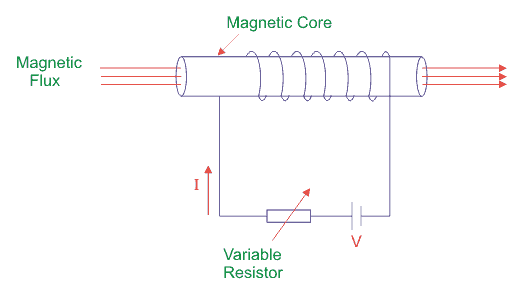Search This Supplers Products:Magnetic materials, magnetic equipment and devicesAuto Partstelecom devicesElectronicselectricalsmetals
What is "Hysteresis Loop"?
publisherWilliam
time2019/07/01

- Introduction of Hysteresis Loop.
To understand hysteresis loop, we suppose to take a magnetic material to use as a core around which insulated wire is wound. The coils is connected to the supply (DC) through variable resistor to vary the current I. We know that current I is directly proportional to the value of magnetizing force (H) as below, where, N = no. of turn of coil and l is the effective length of the coil. The magnetic flux density of this core is B which is directly proportional to magnetizing force H.

Now, we should
be familiar with some important terms related to hysteresis Loop.
1, Definition of Hysteresis
Hysteresis of a magnetic
material is a property by virtue of which the flux density (B) of this material
lags behind the magnetizing force (H).
2, Definition of Coercive Force
Coercive force is defined
as the negative value of magnetizing force (-H) that reduces residual flux
density of a material to zero.
3, Residual Flux Density
Residual flux
density is the certain value of magnetic flux per unit
area that remains in the magnetic material without presence of magnetizing
force (i.e. H = 0).
4, Definition of Retentivity
It is defined as the degree to which a magnetic material gains its magnetism after magnetizing force (H) is reduced to zero.

- Step 1:
When supply current I = 0, so no existence of flux density (B) and magnetizing force (H). The corresponding point is ‘O’ in the graph above. - Step 2:
When current is increased from zero value to a certain value, magnetizing force (H) and flux density (B) both are set up and increased following the path o – a. - Step 3:
For a certain value of current, flux density (B) becomes maximum (Bmax). The point indicates the magnetic saturation or maximum flux density of this core material. All element of core material get aligned perfectly. Hence Hmax is marked on H axis. So no change of value of B with further increment of H occurs beyond point ‘a’.
- Step 4:
When the value of current is decreased from its value of magnetic flux saturation, H is decreased along with decrement of B not following the previous path rather following the curve a – b. - Step 5:
The point ‘b’ indicates H = 0 for I = 0 with a certain value of B. This lagging of B behind H is called hysteresis. The point ‘b’ explains that after removing of magnetizing force (H), magnetism property with little value remains in this magnetic material and it is known as residual magnetism (Br). Here o – b is the value of residual flux density due to retentivity of the material. - Step 6:
If the direction of the current I is reversed, the direction of H also gets reversed. The increment of H in reverse direction following path b – c decreases the value of residual magnetism (Br) that gets zero at point ‘c’ with certain negative value of H. This negative value of H is called coercive force (Hc) - Step 7:
H is increased more in negative direction further; B gets reverses following path c – d. At point‘d’, again magnetic saturation takes place but in opposite direction with respect to previous case. At point‘d’, B and H get maximum values in reverse direction, i.e. (-Bm and -Hm). - Step 8:
If we decrease the value of H in this direction, again B decreases following the path de. At point ‘e’, H gets zero valued but B is with finite value. The point ‘e’ stands for residual magnetism (-Br) of the magnetic core material in opposite direction with respect to previous case. - Step 9:
If the direction of H again reversed by reversing the current I, then residual magnetism or residual flux density (-Br) again decreases and gets zero at point ‘f’ following the path e – f. Again further increment of H, the value of B increases from zero to its maximum value or saturation level at point a following path f – a.
The path a – b
– c – d – e – f – a forms hysteresis loop.
[NB: The shape and the size of the hysteresis loop depend on the
nature of the material chosen]

Importance of Hysteresis Loop
The main
advantages of hysteresis loop are given below.
- Smaller hysteresis loop area symbolizes less hysteresis loss.
- Hysteresis loop provides the value of retentivity and coercivity of
a material. Thus the way to choose perfect material to make permanent
magnet, core of machines becomes easier.
- From B-H graph, residual magnetism can be determined and thus
choosing of material for electromagnets is easy.
